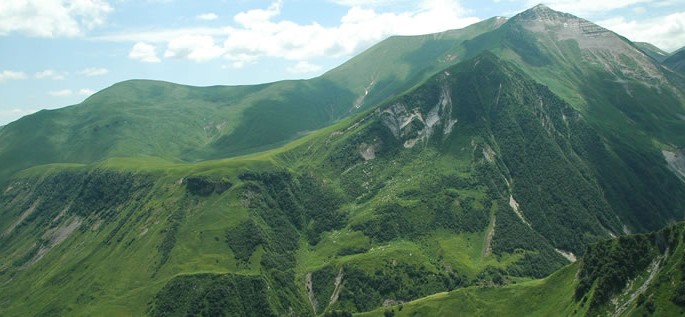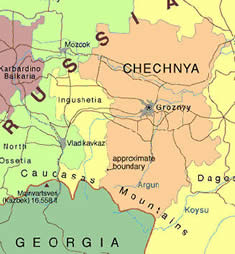
Chechen
Chechen (Нохчийн) is the largest member of the North Caucasian language group. It is spoken in geographically diverse regions of the world ranging from Russia and Western Europe to the Middle East. According to the Russian census of 2002, there are 1,350,000 speakers of Chechen. Due to continuous wars in the region as well as deportations during the Stalinist period, there is a large Chechen diaspora that includes the Republic of Georgia, Germany, Jordan, Kazakhstan, Kyrgyzstan, Syria, Turkey, and Uzbekistan.

Status
- Chechnya
Chechen is the statutory provincial language in the Republic of Chechnya which is part of the Russian Federation (Ethnologue). Russian is the language of wider communication, while Chechen is spoken mostly among Chechens. In urban areas, such as the capital of Grozny, Chechens are still Russian-dominant bilinguals with an imperfect knowledge of Chechen, even though it is taught in schools and used in electronic and print media. - Dagestan
Chechen is preserved by groups of ethnic Chechens who were deported to Dagestan and Georgia in the 1940s and 1950s. It is taught in schools in the Chechen-speaking area of Dagestan. - Central Asia
Chechen is also preserved by descendants of 19th century deportees in Turkey and Jordan. A few are literate in the Cyrillic-based writing system.
Dialects
Chechen has a number of mutually intelligible dialects, even though it is spoken in geographically widespread areas of the world (Ethnologue). The differences between dialects are mostly phonological. Not all dialects have a fully developed writing system.
- Ploskost (central lowland) on which literary Chechen is based
- Itumkala (Shatoi)
- Melkhin
- Kistin
- Cheberloi
- Akkin
- Galanchoi
Structure
Sound system
Chechen has a complex phonological system with large inventories of both vowels and consonants, including ejectives, uvulars, and
pharyngeals.
Vowels
Unlike most other Caucasian languages, Chechen has a large inventory of vowels and diphthongs. Except for /ə/, all vowels can be long or short. Length is significant since it makes a difference in meaning. It is represented by a colon after the vowel. In addition, Chechen has a number of diphthongs (ie, ie:, uo, uo:, ye, ye:), also distinguished by length. The vowel chart below is based on Komen, 2006). There are other, somewhat different analyses of the Chechen vowel system. .
| Close |
i, i:
|
y, y:
|
x
|
u, u:
|
| Close-mid |
e, e:
|
x
|
o, o:
|
|
| Mid |
ə
|
|||
| Open |
a, a:
|
x | ||
- /y/ similar to the second vowel in statue
Consonants
The phonemic inventory of Chechen differs somewhat, depending on the analysis. The chart below is based on Nichols and Vagapov, 2004.
|
Postalveolar
|
Palatal
|
|||||||||
| Stops | voiceless aspirated |
p
|
xxx |
t
|
xxx |
k
|
q
|
xʡ | ʔ | |
| voiceless pharyngealized |
p’
|
xx |
t’
|
x |
k’
|
q’
|
x | x | ||
| voiced |
b
|
xx |
d
|
x |
g
|
x | ||||
| Fricatives | voiceless |
s
|
ʃ
|
x
|
ħ
|
h
|
||||
| voiced | x | v |
z
|
ʒ
|
ɣ
|
ʕ
|
x | |||
| Affricates | voiceless aspirated | x | x |
ts
|
tʃ
|
x | x | x | x | |
| voiceless pharyngealized | x | x |
ts’
|
tʃ’
|
x | x | x | x | ||
| voiced | x | x |
dz
|
dʒ
|
x | x | x | x | ||
| Nasals | x |
m
|
xxx |
n
|
xxxx | x | x | |||
| Lateral | x | xxx |
l
|
xxxx | x | x | ||||
| Rhotic | voicelessv | xxx | x | x | ||||||
| voicedv |
r
|
|||||||||
| Semivowels | xv | x | x |
j
|
x | x | x | x |
- /p’, t’, k’, q’, ts’,tʃ’/ are pharyngealized consonants with no equivalents in English
- /x/ and /ɣ/ have no equivalents in English
- /ħ/ and /ʕ/ have no equivalents in English
- /ʃ/ = sh in shop
- /ʒ/ = s in vision
- /tʃ/ = ch in chop
- /dʒ/ = j in jet
- /r., r/ have no equivalents in English
- /j/ = y in yet
Stress
Stress in Chechen words normally falls on the first syllable, except in borrowed and international words which preserve the position of their original stress.
Grammar
Chechen uses both agglutination and inflection to mark grammatical categories. In an agglutinative language affixes do not become fused with each other and do not change their form. They are simply strung one after another in a prescribed sequence with each affix representing one unit of meaning, e.g., plural, present tense, 1st person, etc., whereas in an inflective (synthetic) language, affixes become fused together so that one affix can represent several units of meaning, e.g., in the Russian word babushka ‘grandmother’, the affix -a at the end of the word represents ‘nominative case + feminine + singular’.
Chechen is an ergative language, i.e., it treats the object of a transitive verb and the subject of an intransitive verb in the same way, while treating the agent of a transitive verb differently. This contrasts with a nominative-accusative language, such as English, which treats the subject of transitive and intransitive verbs in the same way, and the object of a transitive verb differently. This difference is illustrated in the table below.
|
Nominative-Accusative language
|
Ergative language
|
|
|---|---|---|
| Object of transitive verb |
same
|
different
|
| Subject of intransitive verb |
same
|
same
|
| Agent of transitive verb |
different
|
same
|
Nouns and pronouns.
- Chechen nouns are marked for case, number and class.
- There are 8 cases: nominative (subject of intransitive verbs and direct object of transitive verbs), genitive (possession), dative, ergative (subject of transitive verbs), allative (a type of locative case with the basic meaning of ‘onto”), lative (a type of locative case with the basic meaning of ‘motion toward’), instrumental, and comparative. Cases are marked by suffixes. Click here for more detailed information on Chechen cases (in Russian).
- There are two numbers: singular and plural. Plural is marked by a suffix, e.g.,kor ‘door’ and korash ‘doors.’ The plural stem is not always predictable from the singular stem.
- There are two genders: masculine and feminine. They are marked by prefixation.
- There are ten declension classes. They depend on whether together with case endings they take an ablaut (change of the stem vowel) or an extension or pre-case suffix. Some nouns have both ablaut and extension. The ten classes are based only on the singular paradigm.
- There is an inclusive and an exclusive form for the first person plural pronoun. The inclusive ‘we’ refers to both speaker and hearer while the exclusive ‘we’ refers to the speaker but not the hearer.
- The third person is represented by demonstrative pronouns.
Verbs
Chechen verbs are quite complex. Below is a short list of their major characteristics.
- There is an extremely complex aspectual system characterized by an imperfective-perfective opposition (see Molochieva).
- Regular verbs fall into 34 ablaut classes. Ablaut refers to vowel changes in the verb stem, e.g., English drink-drank or eat-ate. There are four ablaut stem forms:
– the infinitive stem used in infinitive, verbal noun, and negative forms
– the present stem used in present, imperfect, and future tenses and coverbs
– the past stem used in the witnessed past tense
– the perfect stem used in the non-witnessed past, the pluperfect, and anterior coverbs - A few verbs change their stems to agree in number with the subject, if intransitive, or direct object (if transitive).
- A number of verbs distinguish one-time action from a repeated action.
Word order
Word order varies depending on contextual factors. Sentence components that refer to old information normally precede those that introduce new information.
Vocabulary
The vocabulary of Chechen comes from two main sources:
- Native Chechen words, e.g., tag ‘man’, korta ‘head’, borz ‘wolf’.
- Numerous borrowings from other languages, mostly from Russian and Turkic languages. There are also loanwords from Arabic, Persian, Ossetic, and Georgian. Some examples of loanwords are palto from Russian pal’to ‘coat’, parti from Russian partiya ‘party’.
Below are a few basic words and phrases in Chechen in the Latin script.
| Hello | as salamu ‘alaikum |
| Good bye | ‘a dika yooila |
| Welcome | maarsha vooghiil |
| Excuse me | bekhk ma billalah’ |
| No | haa ha’ |
| Yes | ha’ |
| Man, person | stag |
| Woman, wife | zuda |
| Water | khi |
| Sun | maalkh |
| Moon | butt |
| Earth | laatta |
The Chechen numeral system is vigesimal, i.e., based on twenty. Below are the numerals 1-10 in Chechen in transliteration (see IPA transliteration).
|
1
|
2
|
3
|
4
|
5
|
6
|
7
|
8
|
9
|
10
|
|---|---|---|---|---|---|---|---|---|---|
|
tsHa’
|
shi’
|
qo’
|
di’
|
pkhi’
|
yaalkh
|
vworkh
|
baarkh
|
iss
|
itt
|
Writing
Over time, Chechen has been written with several scripts.
- Arabic
When the Chechens converted to Islam in the 16th century, the mullahs introduced Arabic texts. However, the Arabic alphabet for writing Chechen was never standardized. Little is known about this writing because most documents were destroyed by the Soviets in 1944. - Latin
A Latin-based alphabet for writing Chechen was developed in the 1920s. The Latin alphabet used a number of special symbols and diacritics, but failed to distinguish between short and long vowels. - Cyrillic
The Latin-based alphabet was replaced by a modified Cyrillic alphabet in 1938. The new Cyrillic alphabet does not represent the spoken language very well. It also uses the numeral ‘1’ as a letter. In the mid 1990’s there was a move to return to Latin spelling. A modified Latin alphabet was adopted in 1992. This alphabet is a mechanical transliteration of the Cyrillic spelling into a Latin system, based on Turkish and Azerbaijani spelling modified by a number of diacritics. The Chechens in Chechnya are familiar only with the Cyrillic alphabet. Chechen expatriates in Jordan, Turkey, and Syria are generally not literate in Chechen.
The Cyrillic version of the Chechen alphabet is given below.
|
А а
|
Аь аь
|
Б б
|
В в
|
Г г
|
Гl гl
|
Д д
|
Е е
|
Ë ë
|
Ж ж
|
З з
|
И и
|
|
Й й
|
К к
|
Кx кx
|
Къ къ
|
КI кI
|
Л л
|
М м
|
Н н
|
О о
|
Оь оь
|
П п
|
Пl пl
|
|
Р р
|
С с
|
Т т
|
Тl т l
|
У у
|
Уь уь
|
Ф ф
|
Х х
|
Хъ хъ
|
ХI хI
|
Ц ц
|
Цi цl
|
|
Ч ч
|
Чl чl
|
Ш ш
|
ъ
|
Э э
|
Ю ю
|
Юl юl
|
Я я
|
Яl яl
|
I
|
There are several versions of the Latin alphabet for Chechen. None have been standardized.
Difficulty

There is no data on the difficulty of Chechen for speakers of English.